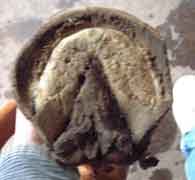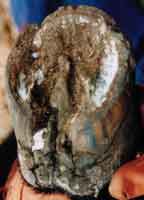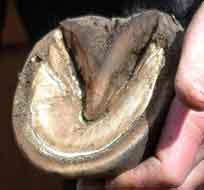When we pull the shoes, nearly all horses are found to have substantial damage to the hooves. It takes about a year of special care to re-build good feet; we call this healing time the "transition year." The occasional horse that doesn't have transition soreness generally had shoes for only a few months.
Horseshoes seem to have been invented in the Middle Ages in Europe, to keep the feet from falling apart when knights' horses had to live for months in slop-filled tie-stalls while the castle was under siege. At that time, the modern study of Anatomy and Physiology did not exist yet, so there was no way to study what the shoes did to hooves and legs.
Horses today are high-priced performance animals and valued companions, and are mostly not kept in unsanitary conditions that rot their feet. A long life and lifelong soundness are important to most horse owners. Therefore, it is time to re-think the use of horseshoes.
There are more than a dozen ways that shoes are known to damage the feet, legs, and circulatory system of the horse (see A Lifetime of Soundness by Dr. Hiltrud Strasser). Some of these are: loss of circulation in the hoof, loss of shock absorption, "white line" damage, and deformity of the hoof shape.
Circulation: When a horse steps down on his foot, the cone-shaped hoof wall flexes wider at the bottom; when he lifts it off the ground, it returns to its narrower "closed" shape. This spread-and-squeeze acts like a pump, pulling blood through the foot with each step.
Horsehoes are nailed onto the foot when it is off the ground in the "closed" position. When he stands on the shod hoof, it cannot flex to the wider position, so the pump doesn't work; not enough blood and nutrients are pulled into the foot to build and maintain strong tissues. A rough estimate is that a medium-sized, barefoot horse pumps a gallon (4 liters) through its four feet in about 20 strides.
Shock absorption: The tough yet elastic barefoot hoof can absorb as much as 2,000 lbs. of concussion. But a horseshoe holds the foot inflexible, cancelling out 75% of its ability to absorb shock. Instead, the concussion travels up the leg and damages joints and tendons.
"White line" damage: As the hoof wall grows, the mechanical forces of walking on a horseshoe pull the toe forward away from the coffin (pedal) bone. The white line stretches, no longer holding wall and bone firmly together. This is called "mechanical founder," and perhaps 3/4 of domestic horses are in this condition.
Deformity: The shod toe flares forward, preventing early breakover; late breakover causes the hoof to land on the toe instead of the heel; toe-first landing leads to increased deformity, including heel contraction, loss of shock absorption, and eventually "navicular" pain.
 |
A very overgrown barefoot hoof, showing how the hoof wall gets wider as it grows. Note the wide frog, and see how close the toe of the sole is to the point of frog. When trimmed, this will be a sound, excellent hoof. |
 |
A very overgrown shod hoof, showing how the shoe has forced the hoof into a cylinder shape. The heels were forced to curl inward, contracting the heels and squeezing the frog. When we clean off the sole, we will see that the toe of the sole is far forward of its correct relationship to the coffin bone. |
A horse's feet keep growing till age 5, when he reaches his full adult weight. When shoes are put on a young horse, the coffin (pedal) bone cannot grow to its full width, therefore the foot will be too small to carry the horse's weight, and is often contracted.
For these and many other reasons, the barefoot horse has many advantages over the shod horse, both in health and in performance.
Here is what Marco Polo noticed on his journey to China:
-
"Afghanistan produces numbers of excellent horses, remarkable for their
speed. They are not shod, although used in mountainous country, and go
at a great pace even down deep descents, where shod horses neither could
nor would go."
Can my horse go barefoot?
Many people ask me whether their horse "can go barefoot." Here are some considerations to help you make your own decision.
1) Since the horse species has been successful for millions of years without shoes, I believe any shod horse would prefer to go barefoot and feel the ground, if we had a way to ask them. A horse depends on his feet to escape from predators, and feels insecure if he can't feel the ground.
2) If you think about it, Horses could go barefoot, except for the ambitions of their owner / rider.
There are situations where shoes are used to extend a horse's abilities beyond what nature provides. An example is stadium jumping, where the horse must have shoes with cleats in order to get around sharp turns at high speed. Cleats give the horse traction, but having enough traction for a tight course overstresses the ligaments and joints in the legs; no-one expects a stadium jumper to be sound and rideable to the age of 35 -- or even 15.
Often a horse would be better off barefoot, in the long run, but the rider is on an unforgiving performance schedule that allows no time for the transition out of horseshoes. For example, a teenager campaigning on the show circuit, where there is a rider age limit, has only three years to reach her goals.
When a horse goes lame, the schedule is no longer a consideration and the barefoot method would be the fastest route to complete soundness.
A correct "wild horse" trim, using hoof boots for riding, makes it possible for most horses to transition with no difficulty. We need to change the rules of competition organizations to allow hoof boots; this is starting to happen, most notably in endurance racing.
3) Some horses work in situations that require hoof protection. Amish buggy horses are driven 20 miles a day on paved highways, where the abrasive surface wears the feet faster than they can grow. We can use hoof boots to protect the hoof; this is one situation where you would need boots on all four feet.
4) Some horses are described as having "bad" or "weak" feet that "would not do well barefoot." But horses get "weak feet" in the first place, from reduced circulation in the shod foot; or, looking to their early life, from the foal not getting enough movement on firm footing.
With the added protection of hoof boots, these horses are showing us that they grow new, tough hooves just like any other barefoot horse. If you look at a "weak" hoof several months after pulling the shoes, you'll actually see a line where the new hoof wall at the top is suddenly thicker than the older wall below.
5) We saw a few horses get a thin, soft sole -- squishy to thumb pressure -- due to a very wet year (2003-4) in the northeastern U.S. They were sore and in fact there was danger of breaking the coffin bone should they land hard on a sharp rock. The two that I heard about went sound immediately with shoes and pads. They were able to go barefoot again when the weather dried out.
